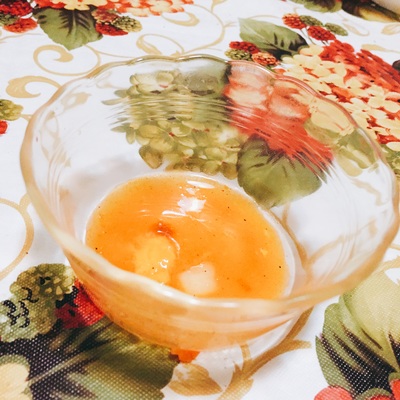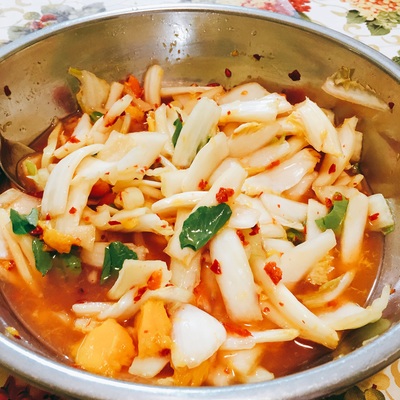|
The themed food for this month of March is kimchi. Why kmchi? When I think of March, I think of St. Patrick's Day and a dish associated with that holiday are cabbage rolls. I associate cabbage with kimchi. Plus it's a good excuse for me to visit a small local Asian grocery. Up until my junior year in college, I have never heard of kimchi nor known about its existence- until I took an Intro to Korean Culture class(to fill one of my humanities requirements). I was exposed to a lot of new terms and dishes associated with the Korean culture. My first taste of kimchi was a sample some students brought in during the group presentations of our final projects. Kimchi is not that bad. It's spicy but I kind of like it. Yet finding a jar of kimchi is hard to find where I live unless I either go to a gourmet supermarket or head to an Asian grocery. During my trip to the Asian grocery, I bought champagne mangos(also known as atalufo mangos), Napa cabbage, and a 4 pound jar of the only kimchi the store was selling(to consume and use in future kimchi recipes). This grocery also has a restaurant inside it that mainly makes Filipino food, so I had Dingguan(a stew with pork blood in it) for lunch. The Dingguan was a bit iron-y(but that's par for the course considering the liquid in the stew was pig blood), gritty from the pork belly, and slightly spicy. But it was delicious. Traditionally, kimchi is fermented for weeks or months before consuming. It's a way to pickle vegetables for the winter. But I managed to stumble upon a kimchi recipe that takes only 24 hours to ferment: http://www.foodandwine.com/recipes/sparkling-white-kimchi. The recipe in this link uses 7Up but the same principles apply- use some sort of carbonated beverage in the kimchi(doesn't have to be soda). Instead of scallions(which are hard to come by where I live), I used onions instead. Onions aren't exactly a direct substitution for scallions but shallots are(which I also couldn't find). Shallots are a good substitute for onions. I also didn't want to deal with large chiles so I used dried chili pepper flakes instead. You may be wondering why I used 2 1/3 tbsp. of the flakes- there are 6 chili peppers in the little jar of chili pepper flakes- 20 tbsps., I figured 1 chili pepper = 3 1/3 tbsp.(I know, the math is wrong), but I thought 3 tbsp. of chili pepper flakes was too much, so I reduced it to a manageable 2 tbsp.- and a 1/3 tbsp. The way kimchi is traditionally eaten is with rice- my dad brought leftover pizza from his stay with my grandma when she was at the hospital so I figured, why not top the pizza with kimchi? The pizza really offsets the kimchi's spiciness with the cheese. Similarly, I recommend you drink milk with kimchi. Peppers have capsaicin and drinking water doesn't help with reducing the burning sensation in your mouth from spicy foods- but dairy products do. During the fermenting process, my home really stank of onions so I Googled for ways to reduce kimchi odors and one way is to put a box of open baking soda next to the offending culprit(in this case, the kimchi). This life hack worked instantly, making the air in my house breathable. Time to halve and core the cabbage: 30 minutes Time to get rid of the moisture: 1 hour Time to ferment the kimchi: overnight or 24 hours Makes 4 cups of kimchi You will need: For the equipment: A ruler(for measuring the 2 inch strips of cabbage) A large bowl(or two; I only had one) A colander Small plates A 1 lb. can (I used a can of baked beans but any 1 lb. weight will do) Plastic wrap(if you're using a Mason jar, you don't need this) For the kimchi: 1 pound of Napa cabbage, halved & cored(see http://www.wikihow.com/Core-a-Cabbage on how to do this (I used Method 2)) 1 tbsp. of salt 1 tbsp. of champagne vinegar(you can use rice vinegar if you don't have champagne vinegar) 1 diced onion 2 1/3 tbsp. of dried chili pepper flakes 18 chopped up baby carrots 1 chopped up champagne mango(atalufo mango) 1 1/2 cups of white sparkling grape juice 1/3 cup of watercress leaves 1. Cut the halved and cored cabbage into 2 inch strips. I used a ruler to measure out a 2-inch white strip of cabbage and then I used said strip as a stencil for cutting the cabbage. Remove the leaves from the white strips. 2. Put the white cabbage strips into a large bowl or two. If you only have one large bowl, you can discard the cabbage leaves. Otherwise you really should use most of the cabbage in the kimchi. But alas, I only had one bowl. :( 3. Wash the cabbage and drain the water from the cabbage using a colander. 4. Mix the salt into the cabbage so that it is distributed evenly. 5. To get rid of the moisture, place a plate smaller than the width of the large bowl on top of the cabbage and weigh the cabbage down using a 1 pound can at room temperature for an hour. You should notice the cabbage deflating when the can sinks further into the bowl. 6. Drain the cabbage to get rid of any remaining moisture using a colander. 7. Add the next 6 ingredients to the large bowl. Mix everything together so all the liquids and ingredients are distributed evenly. 8. If you have Mason jar(s), put the kimchi in the jar(s). Otherwise, cover the top of the large bowl with plastic wrap. 9. Let the kimchi ferment in the fridge overnight(or 24 hours). 10. Mix the watercress in with the kimchi. 11. Bon appetit! The kimchi should last for 3 days.
0 Comments
Leave a Reply. |
Archives
October 2019
Categories
All
|



 RSS Feed
RSS Feed